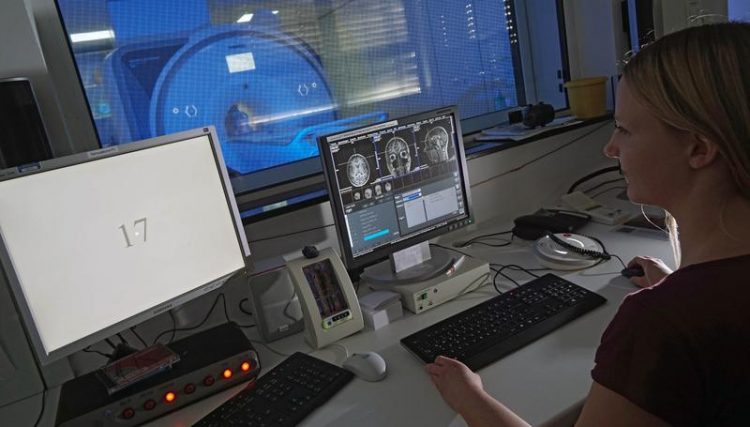Both hemispheres of the brain process numbers

Dr. Mareike Grotheer and colleages were the first to publish high resolution magnetic resonance recordings showing the activity of the 'visual number form area' of healthy test persons. Photo: Jan-Peter Kasper/FSU
The human brain works with division of labour. Although our thinking organ excels in displaying amazing flexibility and plasticity, typically different areas of the brain take over different tasks. While words and language are mainly being processed in the left hemisphere, the right hemisphere is responsible for numerical reasoning.
According to previous findings, this division of labour originates from the fact that the first steps in the processing of letters and numbers are also located individually in the different hemispheres. But this is not the case, at least not when it comes to the visual processing of numbers.
Neuroscientists of the Friedrich Schiller University Jena and of the Jena University Hospital discovered that the visual processing of numbers takes place in a so-called 'visual number form area' (NFA) – in fact in both hemispheres alike. The Jena scientists were the first to publish high resolution magnetic resonance recordings showing the activity in this region of the brain of healthy test persons. The area is normally difficult to get access to.
In their study Dr. Mareike Grotheer and Prof. Dr. Gyula Kovács from the Institute for Psychology of Jena University as well as Dr. Karl-Heinz Herrmann from the Department of Radiology (IDIR) of the Jena University Hospital presented subjects with numbers, letters and pictures of everyday objects. Meanwhile the participants’ brain activity was recorded using magnetic resonance imaging (MRI).
Thus the researchers were able to clearly identify the region in which the visual processing of numbers takes place. The small area at the underside of the left and right temporal lobe reacted with increased activity at the presentation of numbers. Letters and other images but also false numbers lead to a significantly lower brain activity in this area.
Although the Jena team already knew from other scientists' previous research where they had to look for the area, a lot of developmental work went into the newly published story. “This region has been a kind of blind spot in the human brain until now,“ Mareike Grotheer says. And here is why: Hidden underneath the ear and the acoustic meatus, surrounded by bone and air, previous MRI scans showed a number of artefacts and thus obstructed detailed research.
For their study the Jena scientists used a high-performance 3 tesla MRI scanner of the Institute of Diagnostic and Interventional Radiology (IDIR) of the Jena University Hospital. They recorded three-dimensional images of the brain of the test subjects at an unusually high spatial resolution and hence with only very few artefacts.
In addition these recordings were spatially smoothed whereby the remaining 'white noise' could be removed. This approach will help other scientists to investigate a part of the brain that until now had been nearly inaccessible. “In this region not only numbers are being processed but also faces and objects,“ Prof. Kovács states.
Original Publication:
Grotheer M, Herrmann KH, and Kovács G.: Neuroimaging Evidence of a Bilateral Representation for Visually Presented Numbers, The Journal of Neuroscience 2016, 36(1): 88-97, DOI:10.1523/JNEUROSCI.2129-15.2016
Contact:
Prof. Dr. Gyula Kovács, Dr. Mareike Grotheer
Institute of Psychology
Friedrich Schiller University Jena
Leutragraben 1, 07743 Jena
Germany
Phone: ++49 3641 / 945936, ++49 3641 / 45983
Email: gyula.kovacs[at]uni-jena.de, mareike.grotheer[at]uni-jena.de
Media Contact
All latest news from the category: Life Sciences and Chemistry
Articles and reports from the Life Sciences and chemistry area deal with applied and basic research into modern biology, chemistry and human medicine.
Valuable information can be found on a range of life sciences fields including bacteriology, biochemistry, bionics, bioinformatics, biophysics, biotechnology, genetics, geobotany, human biology, marine biology, microbiology, molecular biology, cellular biology, zoology, bioinorganic chemistry, microchemistry and environmental chemistry.
Newest articles

NASA: Mystery of life’s handedness deepens
The mystery of why life uses molecules with specific orientations has deepened with a NASA-funded discovery that RNA — a key molecule thought to have potentially held the instructions for…

What are the effects of historic lithium mining on water quality?
Study reveals low levels of common contaminants but high levels of other elements in waters associated with an abandoned lithium mine. Lithium ore and mining waste from a historic lithium…

Quantum-inspired design boosts efficiency of heat-to-electricity conversion
Rice engineers take unconventional route to improving thermophotovoltaic systems. Researchers at Rice University have found a new way to improve a key element of thermophotovoltaic (TPV) systems, which convert heat…



